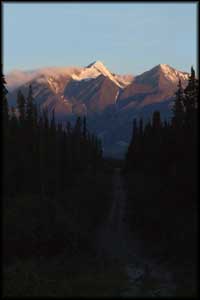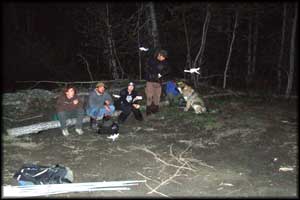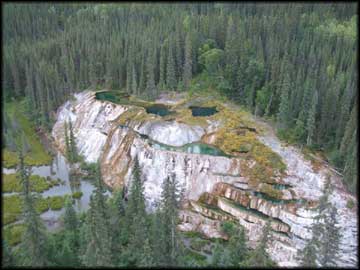 In northern Canada, bats live on the edge. Here the nights are short and the insect-eating season is over in a blink! Studying bats in these harsh environments is challenging and exciting. This sunrise near Haynes Junction, Yukon occurred at 3:00 am.
In northern Canada, bats live on the edge. Here the nights are short and the insect-eating season is over in a blink! Studying bats in these harsh environments is challenging and exciting. This sunrise near Haynes Junction, Yukon occurred at 3:00 am.
 Around the solstice, bats in northern Canada can be seen flying during the mid-night sun; this constant state of twilight adds an interesting dimension of challenge to mistnetting, as bats easily detect mistnets with their eyes. Northern bat surveys are important for establishing baseline biodiversity data — bat distributions are likely to shift quickly as climate change proceeds. What limits these species at the north end of their range is not yet understood.
Around the solstice, bats in northern Canada can be seen flying during the mid-night sun; this constant state of twilight adds an interesting dimension of challenge to mistnetting, as bats easily detect mistnets with their eyes. Northern bat surveys are important for establishing baseline biodiversity data — bat distributions are likely to shift quickly as climate change proceeds. What limits these species at the north end of their range is not yet understood.
Cori’s Yukon bat work in 2007 was funded in part by the Yukon Government, Y2Y Conservation Initiative, Kluane National Park, and Northern Research Institute [Yukon College]. This research was documented as part of a special on the Yukon by Discovery Channel Daily Planet in July 2007. Watch the video clip. [tip: it is slow to start, and you may need to download their video-viewing software after they show you an advertisement! The video is called “Batty Investigation” — press the play button if it doesn’t start automatically.]
 Near Kluane National Park, Yukon, Cori works with other Yukon bat biologists to survey bats. Access is extremely limited near the park, forcing surveys to be conducted in low-lying areas with high grizzly bear density; precautions such as making noise throughout the night and carrying bear spray are always taken. Mosquitoes [white objects seen in foreground of photo] add another dimension of challenge to northern bat surveys!
Near Kluane National Park, Yukon, Cori works with other Yukon bat biologists to survey bats. Access is extremely limited near the park, forcing surveys to be conducted in low-lying areas with high grizzly bear density; precautions such as making noise throughout the night and carrying bear spray are always taken. Mosquitoes [white objects seen in foreground of photo] add another dimension of challenge to northern bat surveys!
 The 2007 Yukon bat survey was a baseline survey across most of southern Yukon, where roads provided access. Cori returned to the Yukon in 2008, this time focusing on more remote locations. One site that was surveyed for small mammals, including bats, was Coal River Springs Territorial Park, a small remote protected area in SE Yukon. Mist-netting around the cold water tufa mound [photo on left] resulted in the capture of two species of bats: little brown myotis and northern myotis.
The 2007 Yukon bat survey was a baseline survey across most of southern Yukon, where roads provided access. Cori returned to the Yukon in 2008, this time focusing on more remote locations. One site that was surveyed for small mammals, including bats, was Coal River Springs Territorial Park, a small remote protected area in SE Yukon. Mist-netting around the cold water tufa mound [photo on left] resulted in the capture of two species of bats: little brown myotis and northern myotis.
One might expect bats in the north to have special adaptations to life in the Midnight Sun. After all, they are nocturnal, trying to make a living during the summer when insects are at their peak intensity, but so is the sun! Jen Talerico and Lea Randall of the University of Calgary completed MSc research projects on this very question. Cori, together with Jen, Lea and Yukon bat biologist Tom Jung, compared little brown bats from the Yukon to those found further south in B.C. where the sun does not remain up all night, and found some interesting and significant differences in their morphology and echolocation calls. These differences align well with the behavioural differences that were noted by Jen and Lea during their Masters research. We are currently working on a publication on the plasticity of echolocation and unique morphology of little brown bats in the north.
